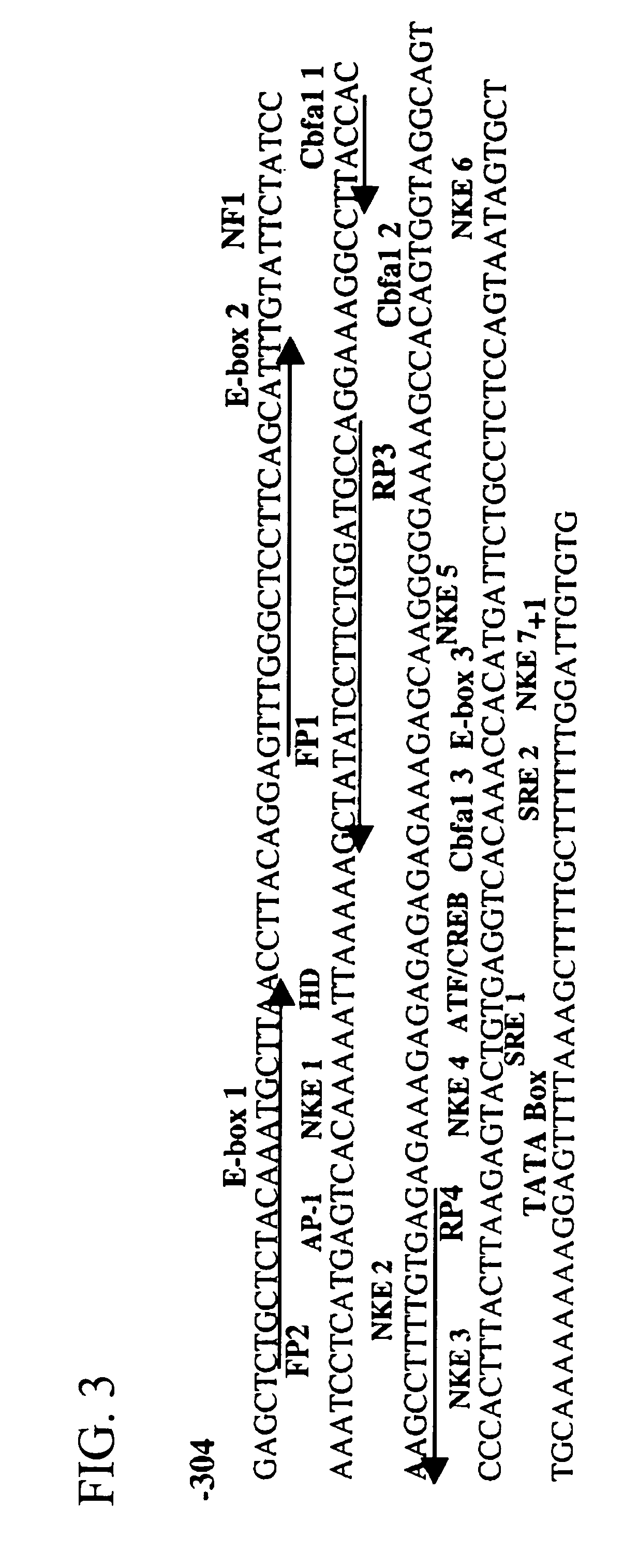Cell-specific molecule and method for importing DNA into osteoblast nuclei
a cell-specific molecule and dna technology, applied in the direction of viruses/bacteriophages, genetic material ingredients, peptides, etc., can solve the problems of limited gene expression, ineffective gene therapy delivered by non-viral plasmid vectors or linear dna molecules, and ineffective entry of large dna molecules into the nucleus, etc., to achieve the effect of promoting nucleic acid transpor
- Summary
- Abstract
- Description
- Claims
- Application Information
AI Technical Summary
Benefits of technology
Problems solved by technology
Method used
Image
Examples
example 1
Preparation of the hCol1α2 Promoter
[0146] The human type I alpha 2 procollagen (hCol1α2) promoter (−267 to +45) was prepared by PCR from an anonymous human genomic DNA sample and was subcloned into the pGL3Basic vector from Promega (Madison, Wis.). The DNA was purified from a blood sample using the PureGene Kit (Gentra). The human collagen promoter was prepared with Pfu DNA Polymerase (Stratagene, La Jolla, Calif.) and with the oligonucleotides: tcgagacaacgagtcagagt; SEQ ID NO:29 and gccagtacctccaacttagc; SEQ ID NO:30, in an MJ Research thermocycler. The PCR product was cloned into the pCR Blunt Vector (Invitrogen, Carlsbad, Calif.), transformed into Top 10 one shot cells (Invitrogen) and grown on Kanamycin plates. DNA was purified and sequenced. The promoter fragment (−267 to +45) was removed from the pCR Blunt vector with Kpn I and Xho I and was subcloned into the pGL3Basic vector at the Kpn I site and Xho I sites for testing of basal promoter activity and nuclear entry activity....
example 2
Analysis of Basal Promoter Activity and Osteoblast Expression Specificity
[0147] The hCol1α2 promoter was one of several promoters tested and compared for strength of basal activity and specificity of expression in rat and human osteoblasts, rat fibroblasts, rat marrow stromal cells and rat chrondrocytes. Table 1 illustrates the activities of these promoters expressed in osteoblasts. The osteoblast promoters were not expressed in other cell types. The hCol1α1, hCol1α2 and Cbfa1 / Runx2 promoters were the most strongly and specifically expressed in osteoblasts.
TABLE 1Analysis of promoter and nuclear entry activity in ROS 17 / 2.8 cells.PromoterNuclear EntryActivity inActivityOsteoblasts(as % of Cells(as % of mousewithSam-OsteoblastOsteocalcinfluorescentplePromoterGene RegionPromoter)nucleus)1m osteocalcin−1393 to +18 10002h osteocalcin−345 to +288403hCollα1 −290 to +17212004hCollα2−267 to +4524730-405hCollα2−107 to +45100-16rCollα1−2050 to +11930007hBSP−1917 to +44 1040-18hCbfa1 / Runx2 ...
example 3
Demonstration that the Type I Alpha 2 Procollagen (hCol1α2) Promoter has Intrinsic Nuclear Entry Activity
[0149] To determine whether any of the osteoblast marker gene promoters can enter the osteoblast nucleus without cell division, protein-free supercoiled plasmid (P) DNA was prepared from the hCol1α1, hCol1α2, hBSP, Cbfa1 / Runx2 and human osteocalcin promoters in the pGL3Basic vector. pGL3Basic plasmid vector or vector with the pGL3Basic, vector containing the hCol1α2 promoter was injected into the cytoplasm of ROS 17 / 2.8 osteoblast-like osteosarcoma cells (approximately 100 cells per plate per promoter construct were injected). Eight hours after microinjection of the plasmid (p) DNA, in situ hybridization was performed with a nick-translated fluorescein labeled pGL3Basic probe. The pGL3Basic vector remained in the cytoplasm, whereas the pGL3Basic vector containing the hCol1α2 promoter rapidly entered the nucleus, as evidenced by fluorescent staining. None of the other promoter se...
PUM
| Property | Measurement | Unit |
|---|---|---|
| Tm | aaaaa | aaaaa |
| pH | aaaaa | aaaaa |
| nucleic acid | aaaaa | aaaaa |
Abstract
Description
Claims
Application Information
 Login to View More
Login to View More - R&D
- Intellectual Property
- Life Sciences
- Materials
- Tech Scout
- Unparalleled Data Quality
- Higher Quality Content
- 60% Fewer Hallucinations
Browse by: Latest US Patents, China's latest patents, Technical Efficacy Thesaurus, Application Domain, Technology Topic, Popular Technical Reports.
© 2025 PatSnap. All rights reserved.Legal|Privacy policy|Modern Slavery Act Transparency Statement|Sitemap|About US| Contact US: help@patsnap.com



